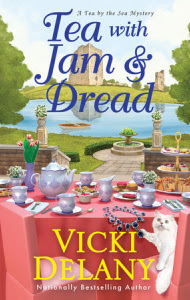 I’m grateful to Riley and friends for allowing me to be a guest here. And I’m grateful to readers! I love my work, and I’d be nowhere without you. Leave a comment here, and your name will go into a daily drawing for one free book. The winner can choose any of my sixteen titles. Old World Murder, one of my American Girl mysteries, a Civil War novel—the choice will be yours!
I’m grateful to Riley and friends for allowing me to be a guest here. And I’m grateful to readers! I love my work, and I’d be nowhere without you. Leave a comment here, and your name will go into a daily drawing for one free book. The winner can choose any of my sixteen titles. Old World Murder, one of my American Girl mysteries, a Civil War novel—the choice will be yours!
Eating Ethnic
by Kathleen Ernst
I grew up in the sixties, in the suburbs of Baltimore. It was a time of gelatin salads and tuna casseroles. On my mom’s side the family had lived on the Jersey shore for a long time, and they did crab cakes really well. My father’s parents were both born in Switzerland, but other than having fondue every once in a while, I don’t recall eating anything particularly Swiss. Our food traditions were pretty mainstream.
 So moving to Wisconsin, and going to work at an historic site that celebrated the state’s rich and diverse European heritage, was a revelation. Old World Wisconsin’s relocated and restored farms and village buildings include fourteen working kitchens, 1845-1915. The site represents Irish, Welsh, Yankee, African-American, Bohemian, German, Polish, Norwegian, Danish, and Finnish immigrants. (The color photo shows two interpreters working in an 1845 Norwegian cabin.)
So moving to Wisconsin, and going to work at an historic site that celebrated the state’s rich and diverse European heritage, was a revelation. Old World Wisconsin’s relocated and restored farms and village buildings include fourteen working kitchens, 1845-1915. The site represents Irish, Welsh, Yankee, African-American, Bohemian, German, Polish, Norwegian, Danish, and Finnish immigrants. (The color photo shows two interpreters working in an 1845 Norwegian cabin.)
I was fresh out of college, and could talk at length about learning styles and theories of museum education. I didn’t know a thing about cooking on a woodstove, or historic cooking or baking. Fortunately, a lot of wonderful women helped me learn what I needed to know. I spent two years an interpreter, working every day in one of the restored homes or farms. Then I moved behind the scenes. Among other things, I coordinated the historic foodways program.
There are lots of ways to research and study people who lived in earlier times, but recreating their food traditions is surely one of the most rewarding. I never forgot the thrill of thinking, I’m tasting what they tasted. Using heirloom produce and period techniques and recipes passed from mother to daughter—perhaps even brought to the Midwest in an immigrant trunk—never got old.
I’ve moved on, but the things I learned at the historic site shaped what I do in my own kitchen. The same thing is true of Chloe Ellefson, the protagonist in my new mystery, Old World Murder. The book is set at Old World Wisconsin, and as the series progresses, Chloe will have the opportunity to explore the food traditions from a variety of ethnic groups.
So, what are your favorite ethnic treats? Who introduced them to you?
 I had a hard time choosing a single recipe to share here today, but finally settled on this German coffeecake. At Old World it’s often made at the 1875 Schottler farm. (The sepia-toned photo is me in the Schottler kitchen back in 1982, cutting up rhubarb for kuchen.) The Schottlers’ granddaughter recalled enjoying the treat with her grandparents.
I had a hard time choosing a single recipe to share here today, but finally settled on this German coffeecake. At Old World it’s often made at the 1875 Schottler farm. (The sepia-toned photo is me in the Schottler kitchen back in 1982, cutting up rhubarb for kuchen.) The Schottlers’ granddaughter recalled enjoying the treat with her grandparents.
Kuchen
2/3 c. sugar
2. eggs, beaten
1 t. salt
1 c. shortening (originally lard)
¼ t. nutmeg
2 oz. yeast, dissolved in ¼ c. warm water
1 c. milk
3-4 c. unbleached flour
fruit—whatever is ripe—cinnamon, and sugar
Put yeast and water and 1 c. flour in mixing bowl. Let sponge set for about 1 hour. Add sugar, salt, nutmeg, shortening, and egg. Add remaining flour and knead. Let rise until almost doubled, 60-90 ninety minutes. Grease a round cake pan or cast iron skillet. Punch down dough, and form dough into pan. Top with sliced fruit, and/or cinnamon and sugar. Bake at 350 degrees until golden brown, about 35-45 minutes. Enjoy!
 Kathleen Ernst is celebrating the publication of her first adult mystery, Old World Murder (Midnight Ink). She has also written eight mysteries for young readers. Several have been finalists for Edgar or Agatha awards. For more information see her website, http://www.kathleenernst.com, or her blog, http://sitesandstories.wordpress.com.
Kathleen Ernst is celebrating the publication of her first adult mystery, Old World Murder (Midnight Ink). She has also written eight mysteries for young readers. Several have been finalists for Edgar or Agatha awards. For more information see her website, http://www.kathleenernst.com, or her blog, http://sitesandstories.wordpress.com.



















































![RileyAdamsFoodBlogPostpic_thumb_thumb[3] RileyAdamsFoodBlogPostpic_thumb_thumb[3]](http://lh5.ggpht.com/_v68WnMKHlKQ/TL8wS_kCFeI/AAAAAAAAB8c/S4RJ191lTho/RileyAdamsFoodBlogPostpic_thumb_thumb%5B3%5D_thumb%5B1%5D.jpg?imgmax=800)






































